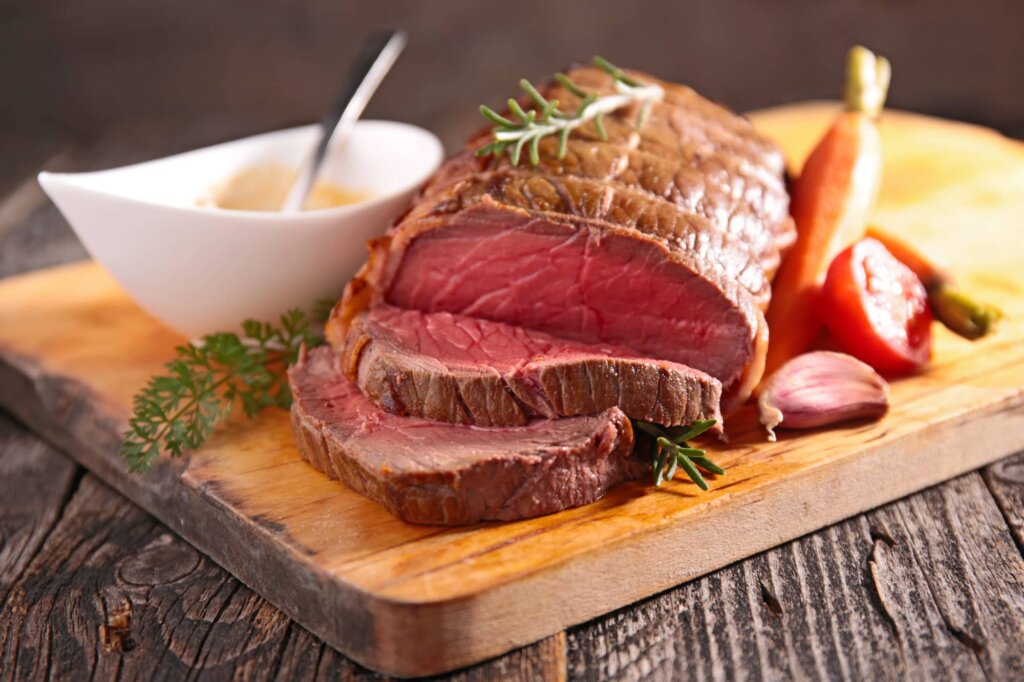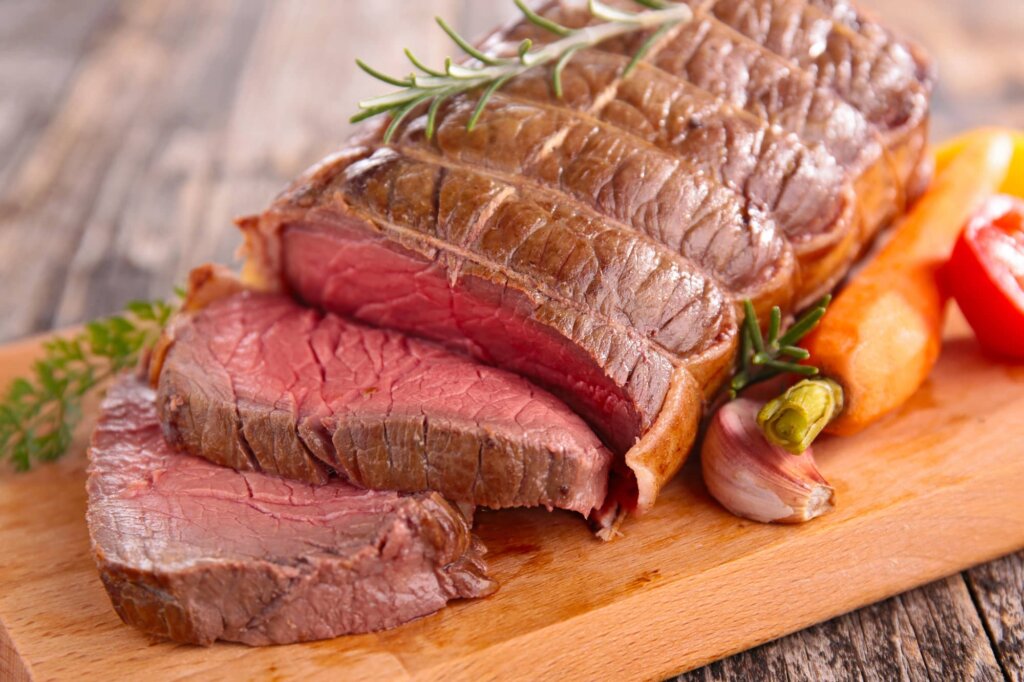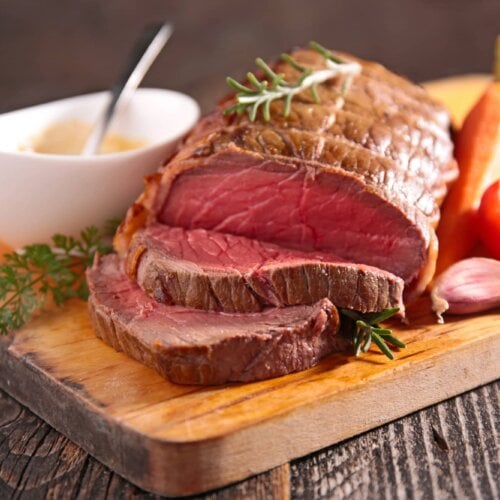
Chateaubriand roast is the most luxurious center-cut portion of the beef tenderloin, spotlighting tender, lean meat and bold, beefy flavor. You’re likely to find it at upscale restaurants, but you can absolutely cook it in your own kitchen to get the same results (and not pay as hefty a price!).
Use this guide to learn how to make this impressive roast at home.
What is Chateaubriand Roast?
Chateaubriand roast is a thick, center-cut portion of the beef tenderloin, favored for its tenderness and fine texture. Not surprisingly, it comes from the same cut as filet mignon; you’ll likely notice similarities when you first bite into its tender meat. However, it’s larger and is usually served as a roast rather than cut into individual portions. In fact, it’s large enough to serve a few people, which is why it’s a go-to for special dinners and holiday meals.
Because it comes from the most tender muscle on a cow, Chateaubriand roast cooks quickly and stays juicy without losing its tenderness. Just be sure not to overcook it! Medium-rare is best for this cut, which is relatively easy to achieve when you roast, smoke, or sous vide it. Many people like to top it with a red wine reduction or béarnaise sauce to finish it off and complement its natural flavors.
Cooking Tips for Chateaubriand Roast
Cooking Chateaubriand is all about precision and care. It’s a premium cut, so knowing what you’re doing ahead of time can help you prevent costly mistakes. Consider these tips before cooking:
- Tie it: Use butcher’s twine to keep the roast uniformly shaped. Do this after seasoning. This trick helps the roast cook evenly, so there are no undercooked or overcooked areas.
- Season early: Salt the roast at least an hour before cooking to allow the seasoning to penetrate deeper and create a brine, which aids in crisping the outside.
- Use high-heat fat: Try clarified butter or beef tallow when searing to get that golden-brown crust without burning.
- Rest: Let the roast rest uncovered after cooking so the crust stays crisp instead of steaming under foil.
- Slice against the grain: Doing this helps preserve tenderness with every bite. Even with a tender cut like Chateaubriand roast, this makes a noticeable difference.
- Top it: Serve with a rich sauce or compound butter. Chateaubriand’s mild flavor shines when paired with bolder flavors.
Best Cooking Methods for Chateaubriand Roast
Here are three of the most common cooking methods for Chateaubriand roast.
Smoked
Smoke Chateaubriand roast to add some deep, wood-fired flavor but leave its natural tenderness intact. Since this cut is somewhat mild in flavor (beefy, but more like filet mignon than ribeye), the smokiness adds a new layer of taste. Use a mild wood like cherry or pecan and smoke at 225°F until the internal temperature reaches about 120°F, then sear to finish. This cooking method keeps the meat juicy while building flavor over time. Just don’t overshoot the temperature, since too much time in the smoker can dry out this lean cut.
Sous Vide
Sous vide guarantees doneness from the inside out, which is great for a cut like Chateaubriand that requires precision to reach its full flavor and texture potential. Set the water bath to your target temp (around 130°F for medium-rare), and let it cook for 2–3 hours. Finish with a hard sear in a hot pan or grill to form a golden-brown crust. This method keeps the meat incredibly tender, and you don’t have to babysit the roast all day.
Seared and Roasted
This classic technique is one of our favorites for Chateaubriand roast, and it’s probably the easiest if this is your first time cooking this cut. Season the roast generously and sear all sides in a large skillet until browned. Then transfer the roast to a 375°F oven and cook until it reaches your preferred doneness (typically 125–130°F for medium-rare). Use a meat thermometer to track progress. Let the roast rest for at least 10 minutes before slicing.
Seared Chateaubriand Roast with Garlic-Herb Butter Recipe

This recipe includes a simple compound butter to add flavor and a silky finish to your roast.
Ingredients
Roast:
- 1.5–3 lb Chateaubriand roast
- 1½ tsp kosher salt
- 1 tsp freshly cracked black pepper
- 1 tbsp grapeseed or avocado oil
- 1 tsp Dijon mustard
Compound Butter:
- 4 tbsp unsalted butter, softened
- 1 clove garlic, finely grated
- 1 tsp fresh rosemary, minced
- 1 tsp fresh thyme, minced
- ½ tsp lemon zest
- Pinch of salt
Instructions
- Season the roast generously with salt at least one hour before cooking. Place in the fridge; remove 45 minutes before you’re ready to cook.
- Season with pepper. Then, tie the roast with butcher’s twine every 1.5 inches if it’s uneven in shape.
- Preheat your oven to 375°F.
- In a small bowl, mix the softened butter with garlic, rosemary, thyme, lemon zest, and a pinch of flaky salt. Scoop it onto plastic wrap or parchment, roll into a small log, and refrigerate until firm.
- Heat a heavy oven-safe skillet (cast iron works best) over medium-high heat. Add oil and allow to heat for a few minutes. Sear the roast on all sides until browned, about 2 minutes per side. Just before transferring to the oven, brush the top with Dijon mustard.
- Transfer the skillet to the oven and roast until the internal temperature hits 125°F for medium-rare, about 20–25 minutes depending on thickness.
- Move the roast to a cutting board. While it rests for 10 minutes, slice a pat of your chilled garlic-herb butter and place it on top of the roast. Let it slowly melt on the roast.
- Cut the roast into thick slices against the grain and spoon buttery pan juices over the top.
Notes
If you don’t have an oven-safe skillet, place the roast on a wire rack inside a roasting pan after searing it.
Substitutions and Variations
If you can’t find a true Chateaubriand cut, a trimmed center-cut beef tenderloin roast will work just as well. To switch up the flavors of this recipe, swap the garlic-herb butter for a blue cheese butter or one mixed with roasted shallots and thyme. Or make a bolder crust by rubbing the roast with crushed peppercorns and mustard seeds before searing.
What to Serve with Chateaubriand Roast
Chateaubriand roast is rich, tender, and somewhat upscale compared to other types of beef, so it does really well with sides that complement its elegance or bring some lightness to the plate. Here are a few ideas:
- Roasted garlic mashed potatoes
- Baguette or dinner rolls
- Creamed spinach
- Grilled asparagus with lemon zest
- Green beans almondine
Check out more steak side dishes for inspiration.
Conclusion: How to Cook Chateaubriand Roast
You have everything you need to cook Chateaubriand roast at home — the recipe, serving suggestions, cooking methods, and more. That means you can turn this cut into a tender and flavorful centerpiece worthy of any special occasion. Ready to start cooking? Order a premium Chateaubriand roast from Chicago Steak Company and bring restaurant-level dining straight to your table.

Seared Chateaubriand Roast with Garlic-Herb Butter
Ingredients
Roast:
- 1.5 –3 lb Chateaubriand roast
- 1½ tsp kosher salt
- 1 tsp freshly cracked black pepper
- 1 tbsp grapeseed or avocado oil
- 1 tsp Dijon mustard
Compound Butter:
- 4 tbsp unsalted butter softened
- 1 clove garlic finely grated
- 1 tsp fresh rosemary minced
- 1 tsp fresh thyme minced
- ½ tsp lemon zest
- Pinch of salt
Instructions
- Season the roast generously with salt at least one hour before cooking. Place in the fridge; remove 45 minutes before you’re ready to cook.
- Season with pepper. Then, tie the roast with butcher’s twine every 1.5 inches if it’s uneven in shape.
- Preheat your oven to 375°F.
- In a small bowl, mix the softened butter with garlic, rosemary, thyme, lemon zest, and a pinch of flaky salt. Scoop it onto plastic wrap or parchment, roll into a small log, and refrigerate until firm.
- Heat a heavy oven-safe skillet (cast iron works best) over medium-high heat. Add oil and allow to heat for a few minutes. Sear the roast on all sides until browned, about 2 minutes per side. Just before transferring to the oven, brush the top with Dijon mustard.
- Transfer the skillet to the oven and roast until the internal temperature hits 125°F for medium-rare, about 20–25 minutes depending on thickness.
- Move the roast to a cutting board. While it rests for 10 minutes, slice a pat of your chilled garlic-herb butter and place it on top of the roast. Let it slowly melt on the roast.
- Cut the roast into thick slices against the grain and spoon buttery pan juices over the top.

